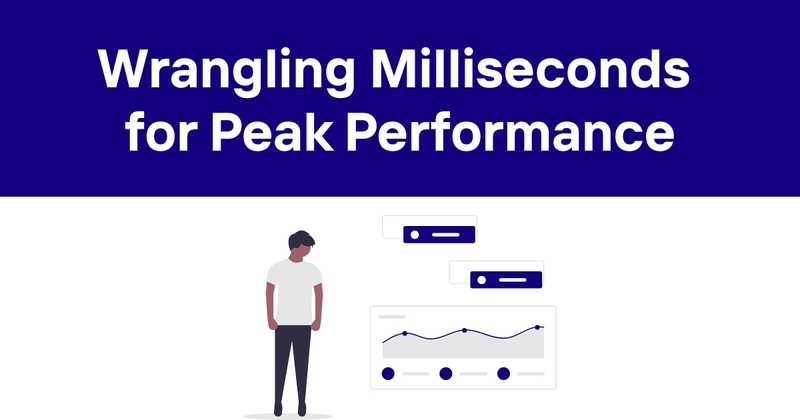API Response Time Explained: Wrangling Milliseconds for Peak Performance
As a developer who's spent countless hours optimizing APIs, I can tell you that response time is the unsung hero of user experience. It's that invisible force that can make or break your application faster than you can say "HTTP request." So grab a cup of coffee (or your beverage of choice), and let's dive into the world of API response times. Trust me, it's more exciting than watching paint dry - barely.
Table of Contents
- What's the Big Deal About API Response Time?
- Decoding API Response Time
- The Showdown: API Latency vs. Response Time
- What's Considered "Good" API Response Time?
- Measuring API Response Time: Tools of the Trade
- The Usual Suspects: Causes of Slow API Responses
- Turbocharging Your API: Optimization Techniques
- Monitoring API Response Time: Stay Vigilant
- The Human Factor: How Response Time Affects User Experience
- Future-Proofing: Preparing for Scale
- Wrapping Up: The Last Word on API Response Time
What's the Big Deal About API Response Time?
Picture this: You're at a fancy restaurant, eagerly awaiting your meal. The waiter takes your order and disappears into the kitchen. Five minutes pass. Ten minutes. Twenty minutes. Your stomach growls. You start eyeing the exit. That's exactly what happens when your API is slow to respond. Except instead of hangry diners, you've got frustrated users ready to abandon your app faster than you can say "server timeout."
API response time is the digital equivalent of service speed in a restaurant. It's the time it takes from the moment a client sends a request to your API until it receives a complete response. And let me tell you, in the digital world, we're not talking minutes - we're talking milliseconds.
Why does this matter? Well, in our instant-gratification-obsessed world, users expect lightning-fast responses. A delay of even a second can feel like an eternity. Slow APIs lead to laggy applications, and laggy applications lead to users heading for the hills (or your competitor's app).
But it's not just about keeping users happy (though that's a pretty big deal). API response time also affects:
- User engagement and retention
- Conversion rates (slow APIs = lost revenue)
- Search engine rankings (Google doesn't like slow websites)
- Server load and operational costs
So yeah, it's kind of a big deal. Now that we've established that, let's break down what API response time actually means.
Decoding API Response Time
API response time is like a race. The starting gun fires when the client sends a request, and the finish line is crossed when the client receives the complete response. Everything that happens in between - data processing, database queries, third-party service calls - all contributes to the total response time.
Here's a simplified breakdown of what happens during an API request:
- Client sends the request
- Request travels across the network to the server
- Server receives the request
- Server processes the request (this might involve database queries, calculations, etc.)
- Server prepares the response
- Response travels back across the network to the client
- Client receives the response
The time taken for all these steps combined is your API response time. Simple, right? Well, not quite. There's more to it than meets the eye.
The Showdown: API Latency vs. Response Time
Now, you might have heard the terms "latency" and "response time" used interchangeably. But they're not quite the same thing. Let me break it down for you:
API Latency is like the time it takes for a message in a bottle to float from one island to another. It's purely the travel time, not including the time it takes to write the message or read it.
In tech terms, latency is the time it takes for a single bit of data to travel from the source to the destination. It's affected by things like physical distance, network congestion, and the number of routers the data has to hop through.
API Response Time, on the other hand, is the whole enchilada. It includes the latency (travel time) plus the time it takes for the server to process the request and generate a response.
To put it another way:
So while latency is a component of response time, they're not the same thing. You could have low latency but still have a slow response time if your server is taking ages to process the request.
What's Considered "Good" API Response Time?
Ah, the million-dollar question. What's a "good" API response time? Well, it's like asking how long a piece of string is - it depends.
In general, here's a rough guide:
- Under 100ms: Blazing fast. Your users will be singing your praises.
- 100-300ms: Pretty good. Most users won't notice any delay.
- 300-1000ms: Okay. Users might start to notice a slight lag.
- Over 1 second: Houston, we have a problem. Users will definitely notice and might start to get frustrated.
But keep in mind, these are just guidelines. The "acceptable" response time can vary depending on the type of application, the complexity of the request, and user expectations.
For example, if you're building a real-time trading application, even 100ms might be too slow. On the other hand, if you're processing a complex report, users might be willing to wait a few seconds.
It's also worth noting that consistency is often more important than raw speed. Users tend to be more forgiving of a consistently "okay" response time than one that's usually fast but occasionally very slow.
Measuring API Response Time: Tools of the Trade
Now that we know what we're aiming for, how do we measure it? Well, there are more tools out there than you can shake a stick at. Here are a few popular ones:
-
Postman: Great for testing individual API endpoints and getting detailed timing information.
-
Apache JMeter: A powerful tool for load testing that can give you response time metrics under various conditions.
-
Pingdom: Offers real-user monitoring and synthetic monitoring to give you a comprehensive view of your API's performance.
-
New Relic: Provides detailed performance metrics and can help you identify bottlenecks in your application.
-
API monitoring services: Tools like Runscope or Assertible can continuously monitor your API and alert you if response times exceed your defined thresholds.
When measuring response time, it's important to look at more than just the average. Pay attention to:
- Median response time: This gives you a better idea of the "typical" experience than the average, which can be skewed by outliers.
- 90th and 95th percentile response times: These tell you how your API performs in "worst-case" scenarios.
- Response time distribution: This can help you identify if you have a consistent response time or if it varies widely.
Remember, measuring is just the first step. The real work comes in interpreting these metrics and using them to optimize your API's performance.
The Usual Suspects: Causes of Slow API Responses
If your API is running slower than a turtle in molasses, there could be several culprits. Let's round up the usual suspects:
-
Inefficient Database Queries: If your API is spending more time chatting with the database than a gossip at a coffee shop, you might need to optimize your queries. Indexes, anyone?
-
Network Latency: Sometimes, it's not you, it's the internet. If your servers and clients are far apart, or if the network is congested, your response times will suffer.
-
Server Overload: If your server is trying to juggle more requests than a clown with bowling pins, response times will inevitably increase.
-
Unoptimized Code: Spaghetti code might be delicious in a restaurant, but it's a recipe for disaster in your API. Inefficient algorithms or unnecessary processing can slow things down.
-
External Service Calls: If your API is dependent on other services, their response time becomes part of your response time. Choose your dependencies wisely!
-
Large Response Payloads: If your API is sending back the entire Library of Congress when all the client needed was a haiku, you're wasting time and bandwidth.
-
Lack of Caching: Are you calculating the same thing over and over? Caching frequently requested data can dramatically improve response times.
-
Inadequate Infrastructure: Sometimes, you just need more horsepower. Underpowered servers or insufficient resources can lead to slow response times.
Identifying the root cause is half the battle. Once you know what's slowing you down, you can start to speed things up.
Turbocharging Your API: Optimization Techniques
Ready to put your API on the fast track? Here are some tried-and-true optimization techniques:
-
Implement Caching: Store frequently accessed data in memory. It's like having a cheat sheet for your API.
-
Optimize Database Queries: Use indexes, avoid N+1 queries, and consider denormalization where appropriate. Your database will thank you.
-
Use Asynchronous Processing: For time-consuming tasks, consider processing them asynchronously and returning a quick acknowledgment to the client.
-
Implement Rate Limiting: Protect your API from being overwhelmed by implementing rate limiting. It's like a bouncer for your server.
-
Compress Responses: Use GZIP compression to reduce the size of your responses. It's like putting your data on a diet.
-
Use a Content Delivery Network (CDN): Distribute your content across multiple, geographically dispersed servers to reduce latency.
-
Optimize Your Code: Refactor inefficient code, use appropriate data structures, and consider compiled languages for performance-critical sections.
-
Implement Connection Pooling: Reuse database connections instead of creating new ones for each request. It's recycling, but for connections!
-
Use Pagination: Instead of returning large datasets all at once, implement pagination to return data in smaller, more manageable chunks.
-
Monitor and Profile: Regularly monitor your API's performance and use profiling tools to identify bottlenecks. You can't improve what you don't measure!
Remember, optimization is an ongoing process. As your API evolves and your user base grows, you'll need to continually reassess and optimize your performance.
Monitoring API Response Time: Stay Vigilant
Optimizing your API is great, but your job isn't done once you've shaved off a few milliseconds. Continuous monitoring is crucial to ensure your API keeps performing at its best. Here's why:
-
Catch Issues Early: Regular monitoring allows you to spot performance degradation before it becomes a major problem. It's like having a check engine light for your API.
-
Understand Usage Patterns: Monitoring can help you understand how your API is being used, allowing you to optimize for common use cases and plan for scale.
-
Validate Optimizations: After making changes, monitoring helps you confirm that your optimizations are actually improving performance.
-
Capacity Planning: By tracking response times over time, you can better predict when you'll need to scale up your infrastructure.
-
SLA Compliance: If you have Service Level Agreements with your API consumers, monitoring ensures you're meeting your commitments.
When setting up monitoring, consider:
- Real-Time Alerts: Set up alerts for when response times exceed certain thresholds. This allows you to react quickly to performance issues.
- Historical Data: Keep historical performance data. This can help you identify trends and plan for future optimizations.
- End-to-End Monitoring: Don't just monitor your API in isolation. Consider the entire request-response cycle, including client-side performance.
- Synthetic Monitoring: Use tools to simulate API requests from different geographic locations to understand global performance.
Remember, the goal of monitoring isn't just to collect data - it's to gain insights that drive action. Regular review of your monitoring data should be part of your development process.
The Human Factor: How Response Time Affects User Experience
Let's take a step back from the technical side for a moment and consider the human impact of API response time. After all, at the end of the day, we're building these APIs for people, not machines.
User experience is dramatically affected by response time, often in ways that aren't immediately obvious:
-
Perceived Performance: Users' perception of your application's speed is often based more on how responsive it feels than on actual measured performance. A well-designed loading indicator can make a 2-second wait feel faster than a 1-second wait with no feedback.
-
Cognitive Load: Slow responses force users to keep more information in their short-term memory. This increases cognitive load and can lead to frustration and errors.
-
Flow State: Fast, responsive applications allow users to enter a "flow state" where they're fully engaged with the task at hand. Slow responses break this flow and reduce productivity.
-
Trust and Credibility: Believe it or not, response time can affect how trustworthy and credible users perceive your application to be. Slow responses can make users question the reliability of your service.
-
Abandonment Rates: Studies have shown that even small increases in load time can lead to significant increases in abandonment rates. Every millisecond counts!
When optimizing for user experience, consider:
- Prioritizing Visual Feedback: Use loading indicators, progress bars, and other visual cues to keep users informed and engaged during longer operations.
- Optimizing Perceived Performance: Techniques like skeleton screens and progressive loading can make your application feel faster, even if the actual load time hasn't changed.
- Consistency: Users often prefer consistent performance over occasionally faster but unpredictable performance. Aim for reliability.
Remember, the goal isn't just to have a fast API - it's to create an experience that users love. Sometimes, that might mean sacrificing raw speed for better perceived performance or user feedback.
Future-Proofing: Preparing for Scale
As your API grows in popularity (fingers crossed!), you'll face new challenges. What works for 100 requests per minute might fall apart at 10,000 requests per minute. Here are some strategies to prepare for scale:
-
Design for Horizontal Scaling: Architect your API so you can add more servers as needed, rather than relying on vertical scaling (bigger, more powerful servers).
-
Use Microservices: Breaking your API into smaller, independently scalable services can make it easier to handle increased load.
-
Implement Caching Strategies: As you scale, caching becomes even more critical. Consider distributed caching solutions like Redis or Memcached.
-
Use Queue-Based Architecture: For operations that don't need immediate responses, consider using message queues to decouple different parts of your system.
-
Plan for Data Growth: As your data grows, your database queries might slow down. Plan for this by implementing strategies like database sharding or read replicas.
-
Automate Everything: Use infrastructure-as-code and automated deployment pipelines to make scaling up (and down) as painless as possible.
-
Implement Circuit Breakers: Protect your system from cascading failures by implementing circuit breakers for external dependencies.
-
Consider Serverless: For certain types of APIs, serverless architectures can provide excellent scalability with minimal operational overhead.
Remember, scaling isn't just about handling more requests - it's about maintaining performance as you grow. Keep monitoring, keep optimizing, and always be prepared for the next order of magnitude.
Wrapping Up: The Last Word on API Response Time
We've covered a lot of ground, from the basics of what API response time is, to strategies for optimizing and scaling. But if there's one thing I want you to take away, it's this: API response time isn't just a technical metric - it's a key factor in the success of your application.
Fast, reliable APIs lead to happy users, higher engagement, and ultimately, business success. Slow APIs, on the other hand, can kill your application faster than you can say "timeout error."
But here's the thing - optimizing API response time isn't a one-and-done task. It's an ongoing process of monitoring, analyzing, and improving. As your API evolves and your user base grows, you'll face new challenges and opportunities for optimization.
That's where tools like Odown come in. With Odown, you get comprehensive monitoring for your websites and APIs, including response time tracking. You can set up alerts for when response times exceed your thresholds, ensuring you're always on top of your API's performance.
But Odown doesn't stop at just monitoring. It also provides public and private status pages, allowing you to keep your users informed about any performance issues or planned maintenance. And with SSL monitoring, you can ensure your API's security is always up to scratch.
In the fast-paced world of web development, staying on top of your API's performance can feel like a full-time job. But with the right tools and strategies, you can ensure your API is always performing at its best, keeping your users happy and your application running smoothly.
So go forth and optimize! Your users (and your future self) will thank you.



